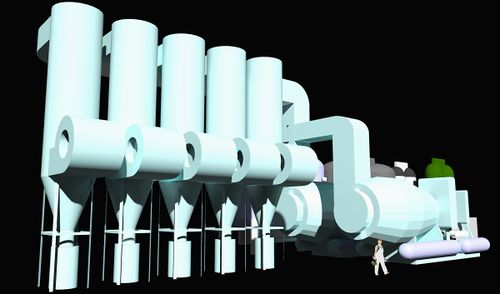Dust collector
A dust collector is a device used to separate dust from air. In some cases clean air is the desired result, in others, the dust is the object of interest.
Most dust collectors operate below atmospheric pressure with the fan on the clean side, after the dust separation system. In the thin martian atmosphere, the available pressure is very low, much lower than the standard operating pressure of dust collectors. So the fan might be required to be put on the dusty side, before the filters.
Dust collectors are filtration systems. For effective filtration of small particles they will often operate in cascade fashion, with a pre-filter and secondary filters.
HEPA grade filters can filter down to 5 microns, removing bacteria. However they have no effect on gases, only dust and particulate matter.[1]
Electrostatic precipitators[2] might be more effective than filters in removing the fine particulates in the martian atmosphere, and a par of most proposals.
Dust collectors might be used in a number of cases:
- Extraction of in situ resources from the martian atmosphere.
- Cabin filtration in vehicles.
- Airlock pump down systems.
- Interior air filtration of a settlement.
- Interior air filtration of settlement production facilities.
The background (average) dust loading of Mars is estimated at 9 e-9 kg/m3[3] and at 1,8e-7 kg/m3[4].
For the latter value, a dust collector treating 1 kg/s of martian atmosphere, about 50 m3/s would need to remove 283 kg per year. This would be sufficient to produce the propellant for 40 Starship type vehicles. So for a single vehicle about 7 kg per year would need to be removed from about 1,1 m3/s (2400 cfm)
| Dust collection | average background | |
| Volume flow rate | m3/s | 50 |
| dust loading | kg/m3 | 1.80E-07 |
| dust capture | kg/s | 9.00E-06 |
| per day | s | 86400 |
| kg/day | 7.78E-01 | |
| per year | kg/year | 283.82 |







